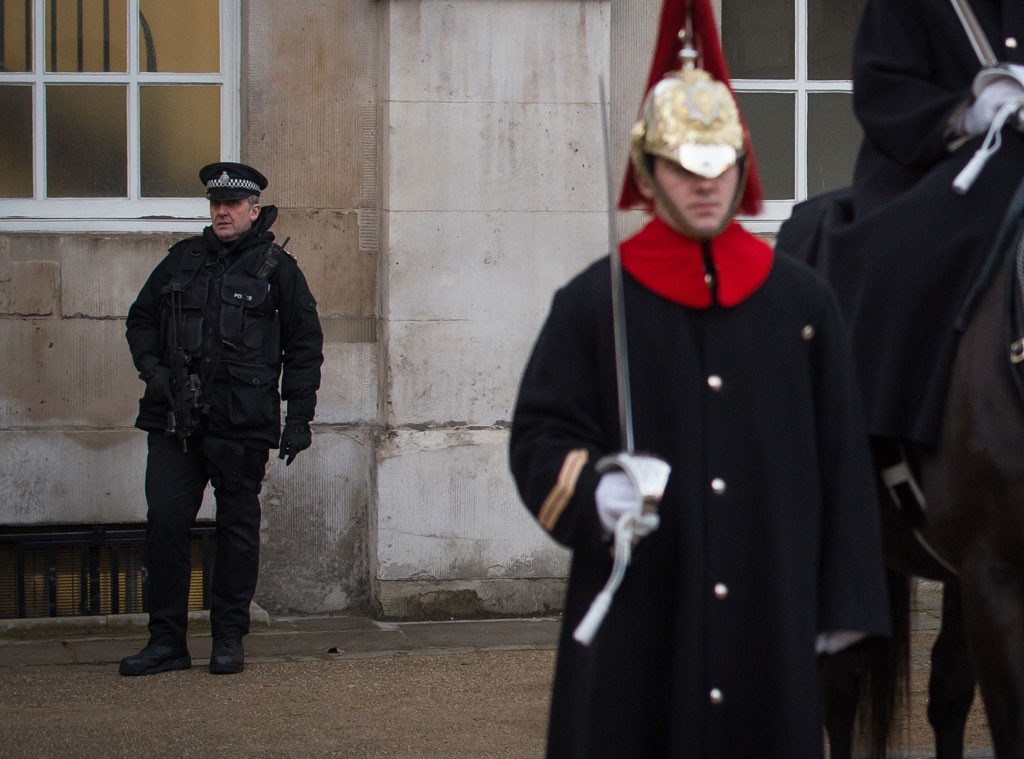 LEON NEAL/AFP/Getty Images
LEON NEAL/AFP/Getty ImagesMany members of the Queen's Guard, the soldiers stationed prominently in front of Buckingham Palace in London and other royal residences, have been moved from their traditional posts and given extra protection themselves amid fears they could be targeted in terror attacks, according to reports.
The U.K. newspaper The Telegraph said just before the New Year's holiday that the guards, who stand or sit on horses silently and often draw tourists seeking a photo opportunity, now stand behind locked gates or fences. They are also accompanied by armed British police officers in areas around the palace, the main residence of monarch Queen Elizabeth II.
Security has also been boosted around Windsor Castle, her weekend home, Clarence House, home of son Prince Charles and wife Camila Parker Bowles and St James's Palace, home of granddaughters Princess Eugenie and Princess Beatrice. Kensington Palace, the London residence of Prince William, wife Kate Middleton and son Prince George, is protected by security guards, although it is unclear if any have been given extra protection.
The Metropolitan Police and Ministry of Defense declined to comment on the reports, Reuters said.
In August, British domestic spy agency MI5 announced that the terrorism threat level in the United Kingdom was raised to "severe," the second-highest level.
"The increase in the threat level is related to developments in Syria and Iraq where terrorist groups are planning attacks against the West," Home Secretary Theresa May said in a statement. "Some of these plots are likely to involve foreign fighters who have travelled there from the U.K. and Europe to take part in those conflicts."
In late October, armed guards began to be stationed near royal residences in London. That month, a man charged into a parliament building in the Canadian capital of Ottawa and killed a soldier on ceremonial sentry duty.
In November, London police arrested four suspected Islamist terrorists who were accused of plotting attacks in the U.K., The Telegraph reported. Recently, The Sunday Times newspaper reported recently that al-Qaeda has instructed and urged "lone wolf" jihadists to carry out bomb attacks on British Airways and easyJet flights.
This marks the first time the royal guards have been ordered not to take sentry duty alone since the height of a terror campaign by the IRA (Irish Republican Army), according to The Telegraph as well as The Daily Mail. In 1998, a peace and power-sharing deal largely ended more than 30 years of violence between mostly Protestant unionists in Northern Ireland and Irish Catholic nationalists seeking to have the province break away from the United Kingdom and become part of Ireland.
Before the agreement was signed, the Queen's Guard was among the IRA's targets. In 1982, two members of the queen's Royal Horse Guards and seven horses were killed in an IRA bomb attack in Hyde Park while they were en route to the Changing of the Guard ceremony at Buckingham Palace. A second blast killed several other people watching an army band perform in Regent's Park, about two miles away.
Despite the new security measures in the United Kingdom, the traditional 45-minute Changing of the Guard ceremonies, popular among tourists, will take place at their usual scheduled times at Buckingham Palace and other royal residences.